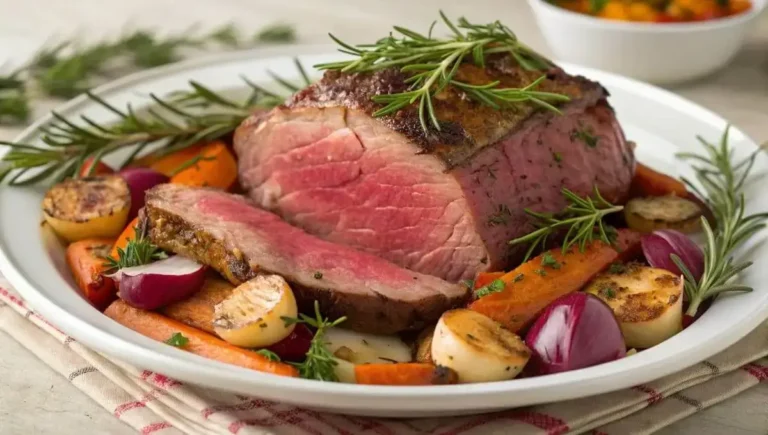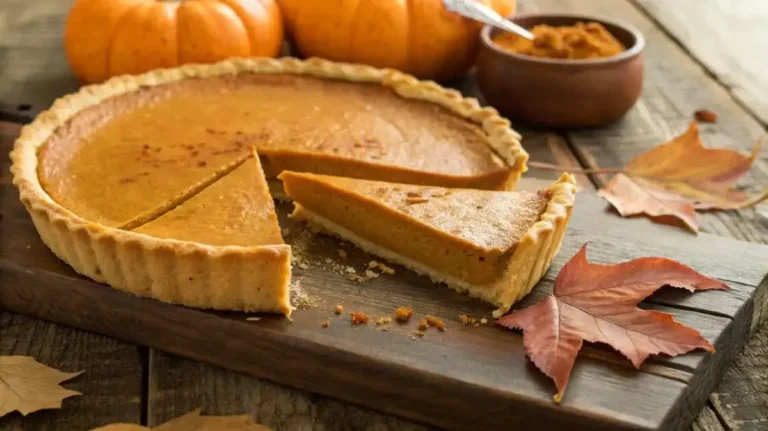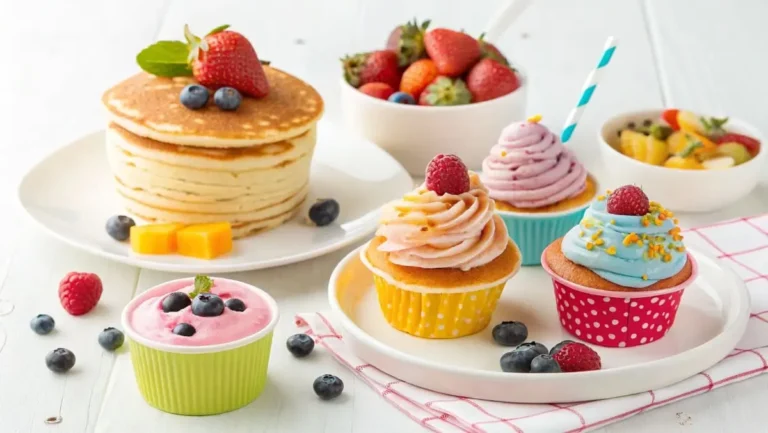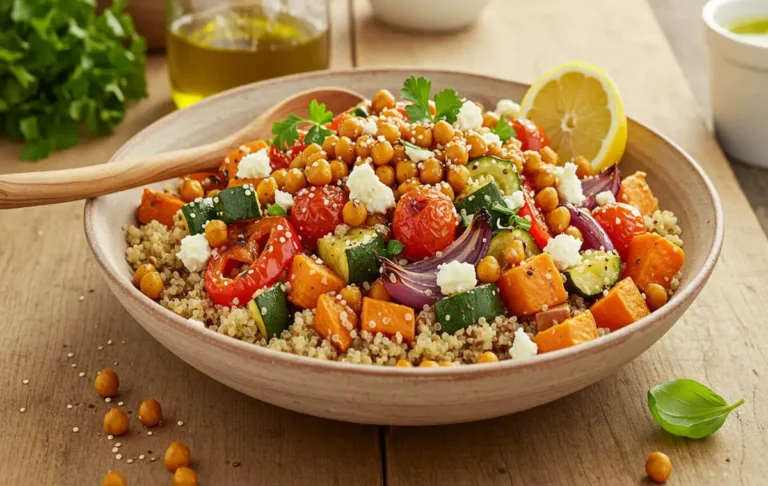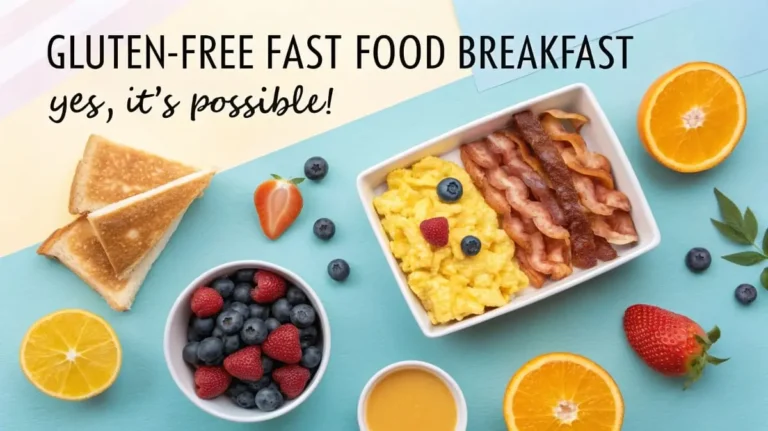Best Gluten Free Flour Blends for Baking Success: A Complete Guide
Are you embarking on a gluten-free baking journey? Whether navigating dietary restrictions due to celiac disease or gluten sensitivity, or simply being eager to explore the exciting world of alternative flours, you’ve likely encountered the vast and sometimes confusing gluten-free flour aisle. Gone are the days of limited gluten-free options! Today, we’re spoiled for choice with a dazzling array of flours, each boasting unique properties and baking potential. But with so many choices – almond flour, coconut flour, rice flour, and more – how do you decipher which flour, or more importantly, which blend of flour, is the key to your baking dreams?
This comprehensive guide is your roadmap to mastering gluten free flour blends. We’ll delve deep into the magic of blending, explore the most popular gluten-free flour options in detail, and equip you with the knowledge and chef-inspired tips to achieve baking success every time. Get ready to unlock the full potential of gluten-free baking and create delicious treats that everyone will love!
For further information on celiac disease and gluten sensitivity, consult reputable resources like: https://celiac.org/ or https://medium.com/@trustdietrecipes/gluten-free-flour-options-a-comprehensive-guide-for-better-baking-01de58277644
Table of Contents
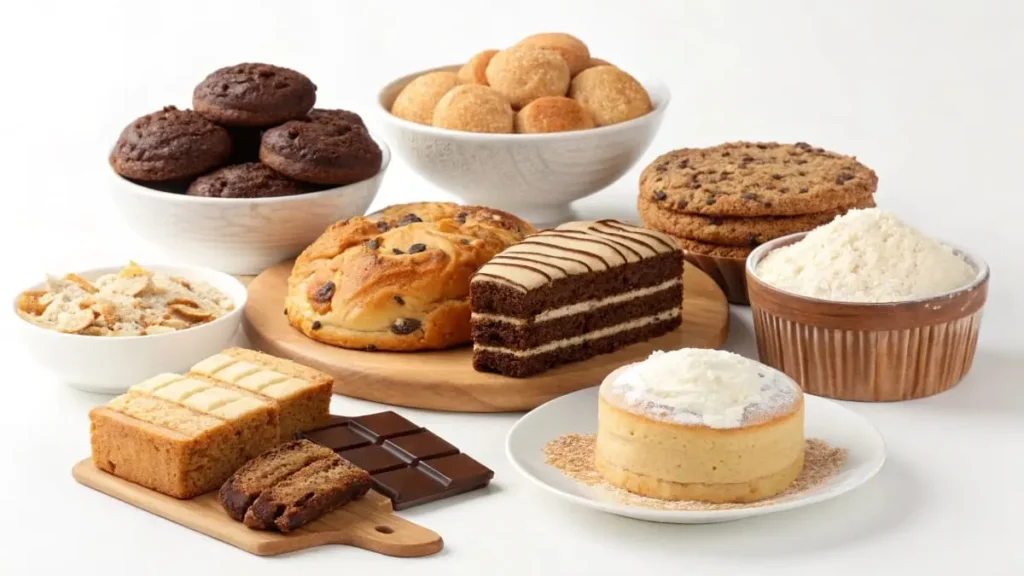
The Science of Gluten Free Flour Blends: Why One Flour Isn’t Enough
Before we dive into individual flours, let’s understand the fundamental principle behind gluten-free baking success: blending is crucial. In traditional baking, wheat flour reigns supreme thanks to gluten. Gluten is a protein that acts as the structural backbone of baked goods. Imagine it as a stretchy, elastic net that develops when wheat flour is mixed with water. This net traps gases produced by yeast or baking powder, allowing the dough to rise and baked goods to achieve their desired texture – the chew in bread, the spring in cakes, and the tenderness in cookies.
Gluten-free flours, by their very definition, lack this vital protein. Baking with a single gluten-free flour often results in disappointment: baked goods can be dry, crumbly, dense, or lack the satisfying texture we expect. This is where the art and science of flour blends come into play.
Think of it like this: Instead of relying on a single superhero (gluten), we assemble a team of specialized heroes, each gluten-free flour contributing unique strengths to mimic the roles gluten plays in baking. By strategically combining flours with different characteristics – some for structure, some for moisture retention, some for binding, and some for flavor – we can create gluten-free baked goods that rival their wheat-based counterparts in taste and texture.
The Role of Gluten vs. Gluten Free Flour Blends in Baking
| Feature | Gluten (in Wheat Flour) | Gluten-Free Flour Blends |
| Primary Role | Provides structure, elasticity, chewiness | Mimic gluten’s functions through combined flour properties |
| Texture Impact | Creates cohesive, stretchy dough, airy crumb | Aims for balanced texture: tender, moist, not crumbly or dense |
| Single Flour Use | Often sufficient for many recipes | Rarely optimal; blends are highly recommended |
| Key Challenge | Over-development can lead to toughness | Achieving proper structure and avoiding dryness/crumbiness |
| Solution | Proper mixing techniques, dough handling | Strategic flour blending, binding agents, recipe adjustments |
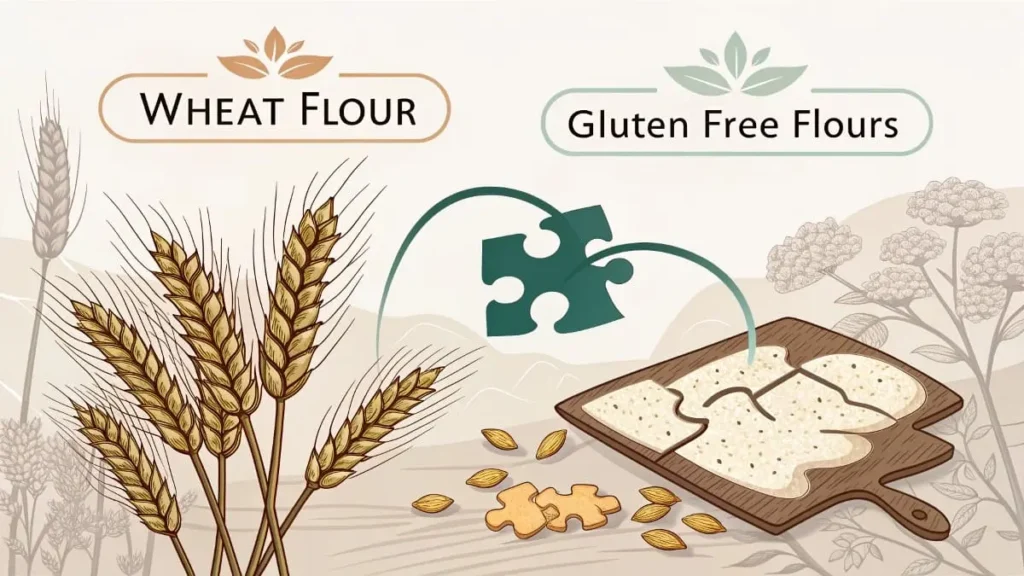
Decoding Gluten-Free Flour Options: Your Comprehensive Guide
Now, let’s explore the individual players on our gluten-free flour team! Understanding the properties of each flour is key to creating successful blends and choosing the right flour for your specific baking needs.
1. Rice Flour: The Versatile Gluten-Free Base
- Types: Rice flour isn’t a one-size-fits-all ingredient. There are several types, each with subtle but important differences:
- White Rice Flour: The most common and readily available. Milled from white rice, it boasts a very fine, light texture and a neutral, mild flavor. Think of it as a blank canvas for your baking creations.
- Brown Rice Flour: Made from brown rice, it retains the bran and germ, resulting in a slightly nuttier flavor and a subtly coarser texture compared to white rice flour. It also packs a nutritional punch with more fiber and nutrients.
- Sweet Rice Flour (Glutinous Rice Flour): Don’t let the name fool you – it’s not sweet in flavor! Made from glutinous rice (also known as sticky rice), this flour is incredibly sticky and starchy when cooked. It’s primarily used as a binder and thickener rather than a main flour in baked goods. Think of its role in Asian cuisines, like mochi.
- Properties:
- White Rice Flour: Fine, light, very mild flavor, can be slightly dried in baked goods.
- Brown Rice Flour: Nuttier, slightly coarser texture, more fiber and nutrients, provides more structure.
- Sweet Rice Flour: Sticky, starchy when cooked, excellent binder and thickener.
- Uses:
- White Rice Flour: Ideal for delicate baked goods where a light texture is desired, such as cakes, cookies, and muffins. Also excellent as a thickener for sauces, soups, and gravies.
- Brown Rice Flour: Adds more substance and flavor to baked goods. Often incorporated into bread blends and heartier recipes like muffins and quick breads.
- Sweet Rice Flour: A powerful binder in gluten-free flour blends, improving texture and preventing crumbiness. Also a key ingredient in Asian desserts and as a thickener in Asian cooking.
- Limitations:
- White and Brown Rice Flour: Can be dry and crumbly if used as the sole flour, especially in recipes that require significant structure, like yeast bread. Lacks the elasticity needed for traditional bread making on its own.
- Sweet Rice Flour: Not suitable as a primary flour for most baked goods due to its extreme stickiness. Best used in small quantities within blends.
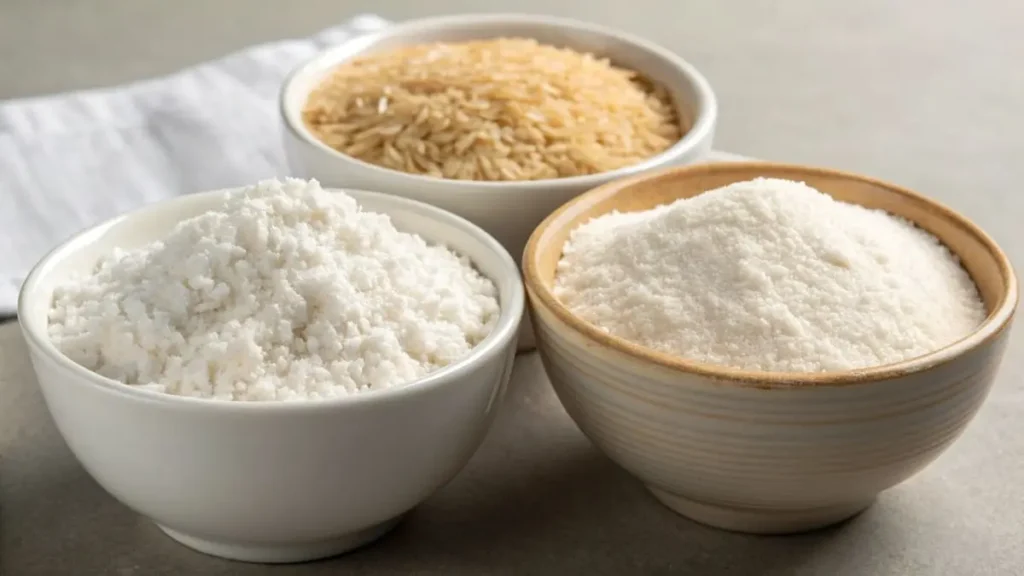
2. Almond Flour: The Nutty, Grain-Free Delight
- Properties: Almond flour is crafted from blanched, ground almonds (skins removed). It boasts a naturally sweet and nutty flavor that enhances baked goods. Its texture is slightly coarse and moist due to its high-fat content. Naturally grain-free and lower in carbohydrates compared to grain-based flour, almond flour is also a good source of protein and healthy fats.
- Uses: Almond flour shines in cakes, cookies, muffins, and quick bread, lending a moist, rich, and tender crumb. It can also be used as a flavorful and gluten-free breading for chicken, fish, or vegetables. Think of French macarons and financiers – almond flour is a star ingredient.
- Limitations: The high-fat content, while contributing to moisture, can also lead to dense baked goods if not balanced with other flours or ingredients. Almond flour is not ideal for recipes requiring gluten-like elasticity, such as chewy breads or pizza crusts. Crucially, it’s unsuitable for individuals with nut allergies. Its cost can also be higher than other gluten-free flours.

3. Coconut Flour: The Highly Absorbent, Tropical Choice
- Properties: Coconut flour is made from dried coconut meat that has been finely ground. Its defining characteristic is its extreme absorbency – it soaks up liquids like a sponge! It carries a distinct coconut flavor, which can range from subtle to pronounced depending on the recipe and other ingredients. Coconut flour is low in carbohydrates and high in fiber, making it a popular choice for specific dietary needs.
- Uses: Coconut flour is typically used in small quantities within gluten-free flour blends to contribute moisture and fiber. It works well in muffins, pancakes, and some types of cakes, often in combination with other flours and a higher ratio of eggs to provide structure and bind the moisture.
- Limitations: Due to its exceptional absorbency, coconut flour recipes demand precise liquid ratios. Using too much coconut flour can result in extremely dry, dense, and even gritty baked goods. The coconut flavor, while appealing in some recipes, can be a limitation if you desire a neutral flavor profile. It also requires a significant amount of liquid and eggs in recipes to function properly.
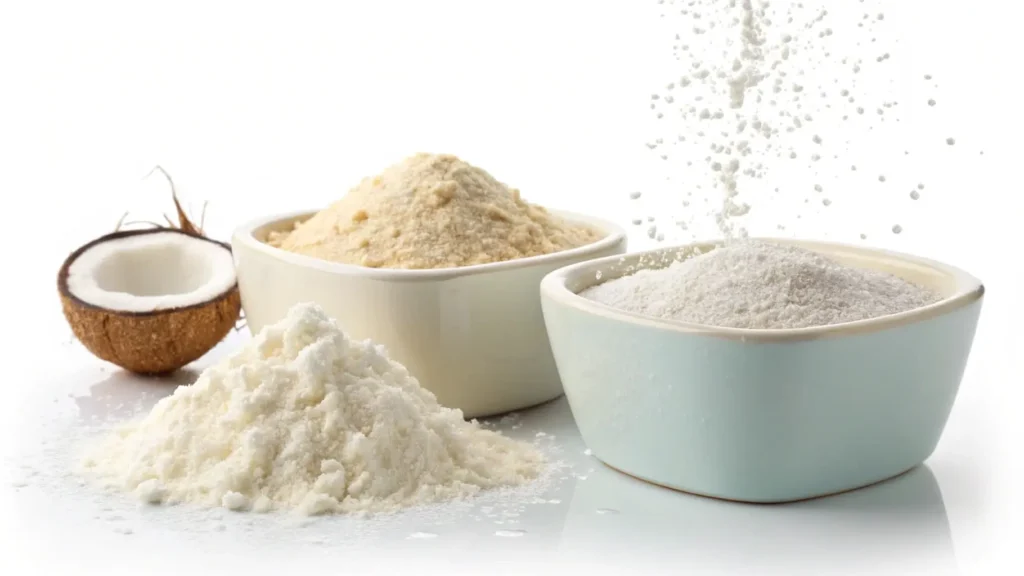
4. Cassava Flour: The Neutral and Versatile Option
- Properties: Cassava flour is derived from the cassava root (also known as yuca). It’s prized for its neutral flavor and light, slightly fluffy texture. Cassava flour is relatively low in carbohydrates compared to some other gluten-free flour and is naturally gluten-free and grain-free.
- Uses: Cassava flour is remarkably versatile. It performs well in cakes, cookies, tortillas, and even as a breading for savory dishes. In certain recipes, it can mimic the texture of traditional wheat flour more closely than some other gluten-free alternatives, making it a promising option for those seeking wheat-like results.
- Limitations: Cassava flour can sometimes exhibit a slightly grainy texture, particularly if it’s not finely milled. It’s generally best used in blends or in recipes where a subtle grainy texture is acceptable. It doesn’t possess strong binding capabilities on its own and may require binders in certain recipes. It’s important to distinguish cassava flour from cassava starch (tapioca starch), which has different properties.
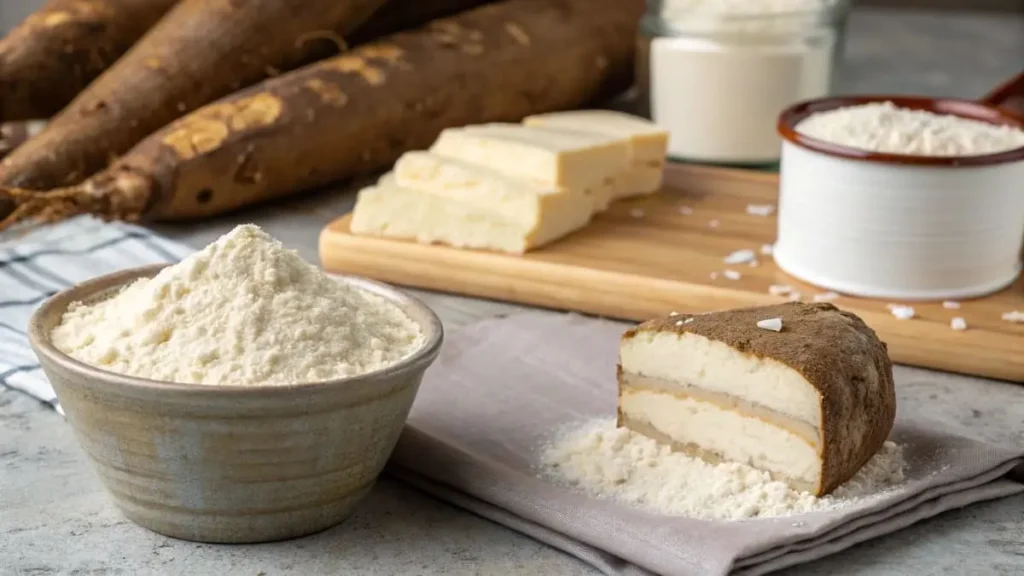
5. Sorghum Flour: The Nutritious and Balanced Choice
- Properties: Sorghum flour is milled from sorghum grain. It offers a slightly sweet and nutty flavor and a relatively fine texture, making it a pleasant addition to gluten-free baking. Nutritionally, sorghum flour is a good source of protein and fiber compared to some other gluten-free flour, adding nutritional value to your baked goods.
- Uses: Sorghum flour is adaptable and can be incorporated into a variety of baked goods, including breads, muffins, pancakes, and cookies. It contributes both structure and moisture to gluten-free recipes, helping to achieve a more balanced texture and prevent dryness.
- Limitations: Sorghum flour can sometimes have a slightly bitter aftertaste if used in large quantities in certain recipes. For this reason, it’s often best used in blends with other flours to mitigate any potential bitterness and balance its flavor profile. Experimentation is key to finding the right ratio in your blends.
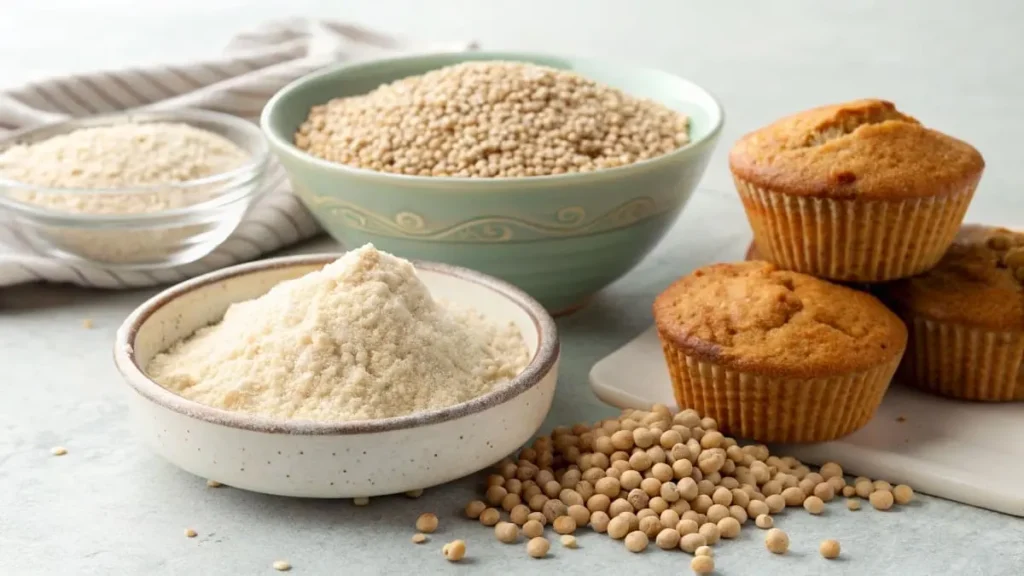
6. Buckwheat Flour: The Earthy and Flavorful (But Not Wheat!) Surprise
- Properties: Despite its misleading name, buckwheat is not related to wheat at all! It’s a seed and is naturally gluten-free. Buckwheat flour has a distinctive and assertive flavor – slightly nutty and earthy, which can be quite pronounced. It adds a unique dimension to baked goods.
- Uses: Buckwheat flour truly shines in pancakes, crepes, and blintzes, where its unique and robust flavor is not only accepted but celebrated. It can also bring a distinctive flavor and slightly coarser texture to other baked goods like muffins and rustic breads. Think of traditional buckwheat pancakes – a perfect example of its flavor profile.
- Limitations: Due to its strong and somewhat polarizing flavor, buckwheat flour is not suitable for all recipes. It can be overpowering if not used thoughtfully. It also tends to produce denser baked goods if used alone in large quantities. It’s most often used in combination with lighter flours to balance both flavor and texture.
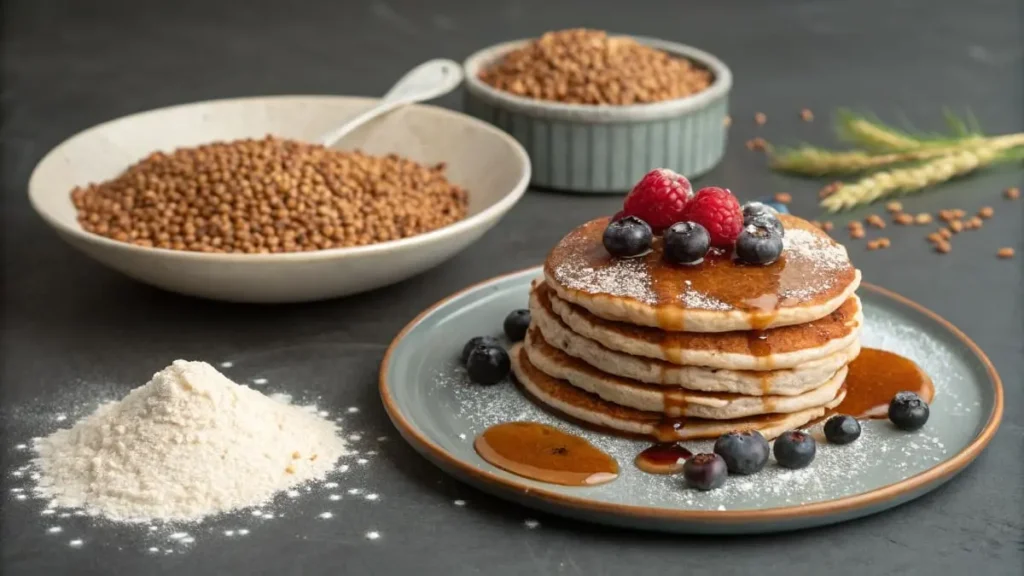
7 & 8. Tapioca Flour/Starch & Potato Flour/Starch: The Starchy Texture Enhancers
- Properties: Tapioca flour/starch and potato flour/starch are both starches derived from root vegetables. They are primarily used for their textural properties rather than as main flours.
- Tapioca Flour/Starch: Made from the cassava root (same origin as cassava flour, but processed differently to isolate the starch). It’s virtually flavorless and possesses a very fine, powdery texture. Tapioca starch is an excellent binder and thickener, contributing to a slightly chewy texture.
- Potato Flour/Starch: Made from potatoes. Also neutral in flavor with a light, fine texture. Potato starch is also a good binder and thickener, adding moisture and tenderness to baked goods. (Note: Potato flour and potato starch are sometimes used interchangeably, but potato starch is generally considered a purer starch with a finer texture and more potent thickening power.)
- Uses: Both tapioca and potato starch are typically used in small amounts within gluten-free flour blends to enhance texture and binding. They work wonders in cakes, cookies, and sauces, creating a lighter, more tender texture and helping to prevent crumbiness. They contribute to a desirable chewiness in cookies and breads.
- Limitations: Neither tapioca nor potato starch provides much structural support on their own. They are primarily texture enhancers and binders. Used in excessive quantities, potato starch can sometimes lead to a slightly gummy texture. They are best utilized as supporting players within well-balanced flour blends.
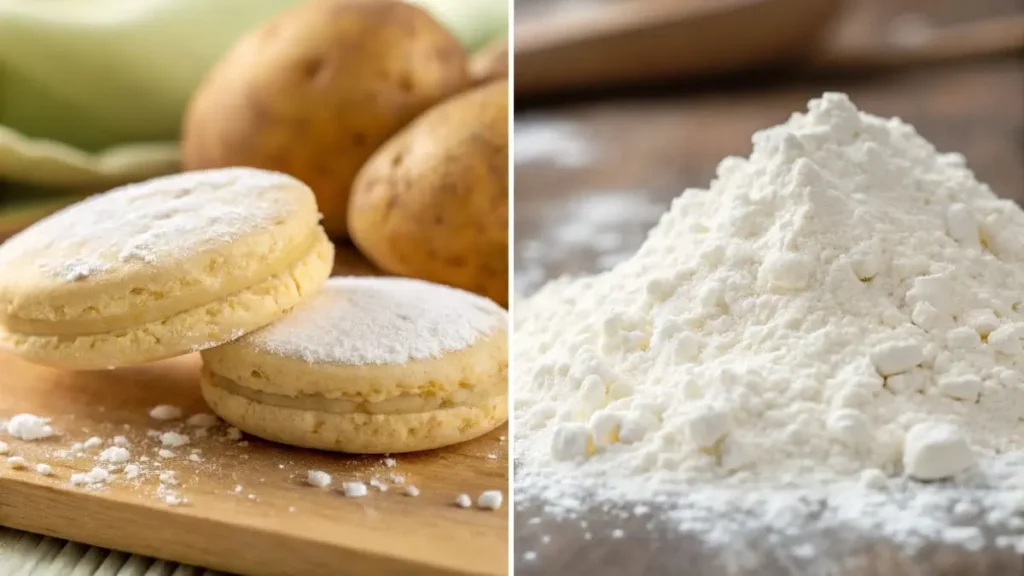
Chef’s Corner: Crafting Your Gluten-Free Flour Blends – A Pro’s Guide
As a chef, I’ve learned that mastering gluten-free baking often comes down to understanding how to create balanced flour blends. While pre-made blends are convenient, crafting your own allows for customization and a deeper understanding of the ingredients. Here’s my chef-inspired approach to creating effective gluten-free flour blends:
- Define Your Baking Goal: What are you making? A delicate cake requires a different blend than a hearty bread or chewy cookie. Consider the desired texture and flavor profile.
- The Base Flour(s): Choose one or two flours to form the foundation of your blend. Good base options include:
- White Rice Flour: For lightness and neutrality.
- Brown Rice Flour: For structure and slightly nutty flavor.
- Sorghum Flour: For balance and mild sweetness.
- Cassava Flour: For versatility and wheat-like texture.
Chef’s Tip: For all-purpose blends, I often start with a combination of white and brown rice flour for a balance of lightness and structure.
- The Starch Component (For Texture & Binding): Starches are essential for mimicking gluten’s binding properties and achieving desired textures. Include one or two starches in your blend:
- Tapioca Starch: For chewiness and binding.
- Potato Starch: For moisture and tenderness.
- Cornstarch (Corn Flour): For lightness (use sparingly as it can be dried in large amounts).
Chef’s Tip: A combination of tapioca and potato starch is my go-to for most baking applications. Tapioca for chew, potato for moisture.
- The Flavor & Moisture Enhancers (Optional but Recommended): These flours add depth of flavor and improve moisture retention:
- Almond Flour: For richness, nutty flavor, and moisture.
- Coconut Flour: In very small amounts, for fiber and subtle sweetness (use cautiously due to absorbency).
- Buckwheat Flour: For a distinct earthy flavor (use sparingly if the desired flavor is mild).
Chef’s Tip: Almond flour can elevate the flavor of many gluten-free baked goods. Use it strategically for cakes, cookies, and muffins.
- Binding Agents (The Gluten-Free Glue): While starches help, binding agents like xanthan gum or guar gum are often necessary to provide the elasticity and structure that gluten would normally offer. Most pre-made blends already include these.
Chef’s Tip: Start with a small amount of xanthan gum (usually ½ tsp to 1 tsp per cup of flour blend) and adjust based on your recipe and desired texture.
Example Blend Recipe: “All-Purpose” Gluten-Free Flour Blend (Chef-Inspired)
This blend is designed to be versatile and work well in a variety of recipes like cakes, cookies, muffins, and quick breads.
- 1 ½ cups White Rice Flour
- ½ cup Brown Rice Flour
- ½ cup Tapioca Starch
- ¼ cup Potato Starch
- 1 tablespoon Almond Flour (optional, for added flavor)
- 1 teaspoon Xanthan Gum
Instructions: Whisk all ingredients together thoroughly until well combined. Store in an airtight container in a cool, dry place.
Example Gluten-Free Flour Blends for Different Baking Needs
| Baking Application | Recommended Flour Blend Components (Example) | Key Flour Properties Emphasized |
| Delicate Cakes & Muffins | White Rice Flour, Tapioca Starch, Potato Starch, Almond Flour (optional) | Lightness, tenderness, moistness |
| Hearty Breads & Pizza | Brown Rice Flour, Sorghum Flour, Tapioca Starch, Potato Starch, Psyllium Husk (binder) | Structure, chewiness, slight elasticity |
| Chewy Cookies | White Rice Flour, Tapioca Starch, Potato Starch, Almond Flour, Oat Flour (GF certified) | Chewiness, slight crispness, flavor |
| Pancakes & Crepes | Buckwheat Flour, White Rice Flour, Tapioca Starch | Flavor, light texture, slight structure |

Essential Tips for Gluten-Free Baking Success: From My Kitchen to Yours
Baking gluten-free requires a slightly different approach than traditional baking. Here are my top tips, honed from years of culinary experience, to help you achieve consistent gluten-free baking success:
- Always Start with a Gluten-Free Recipe: This is non-negotiable! Don’t attempt to simply substitute gluten-free flour into a wheat flour recipe. Gluten-free recipes are carefully formulated with specific flour blends, liquid ratios, and techniques to work optimally without gluten. Seek out recipes specifically designed for gluten-free baking. For more delicious gluten-free recipes and advanced baking techniques, explore our comprehensive guide: https://www.trustdietrecipes.com/the-ultimate-guide-to-gluten-free-baking-master-techniques-delicious-recipes/
- Measure Accurately: Baking is a science, and gluten-free baking is even more precise. Use measuring cups and spoons to accurately measure your flours and liquids. Weighing ingredients (especially flour) is even more accurate and highly recommended for consistent results.
- Don’t Overmix Gluten-Free Batter: Overmixing wheat flour batter can develop gluten, which is sometimes desirable (like in bread). However, in gluten-free baking, overmixing can lead to tough and dense baked goods. Mix just until the ingredients are combined – stop as soon as everything is incorporated, even if there are still a few streaks of flour.
- Embrace Binding Agents: Since gluten is absent, binding agents are often essential to provide structure and prevent crumbiness in gluten-free baking. Xanthan gum and guar gum are the most common and effective binding agents. Most gluten-free recipes will include one of these – don’t skip them! They are crucial for achieving the right texture.
- Adjust Liquid Ratios as Needed: Gluten-free flours can behave differently depending on humidity, brand, and even batch. If your batter or dough seems too dry, add liquid (milk, water, or plant-based milk) one tablespoon at a time until you reach the desired consistency. Conversely, if it seems too wet, add a tablespoon of flour blend at a time.
- Let Batter Rest (Sometimes): Some gluten-free batters benefit from a short resting period (15-30 minutes) before baking. This allows the flour to fully hydrate and can improve the final texture. This is particularly helpful for recipes using coarser flour like brown rice flour.
- Cool Completely Before Slicing (Especially Cakes): Gluten-free baked goods, especially cakes, can be more fragile when warm. Allow them to cool completely to room temperature before slicing and serving. This allows them to firm up and prevents crumbling.
- Experiment and Learn: Gluten-free baking is a journey of continuous learning and discovery! Each flour and each recipe is unique. Be prepared to experiment, adjust recipes, and learn from your baking experiences. Keep notes on what works and what doesn’t. Don’t be afraid to try new things and refine your techniques over time.
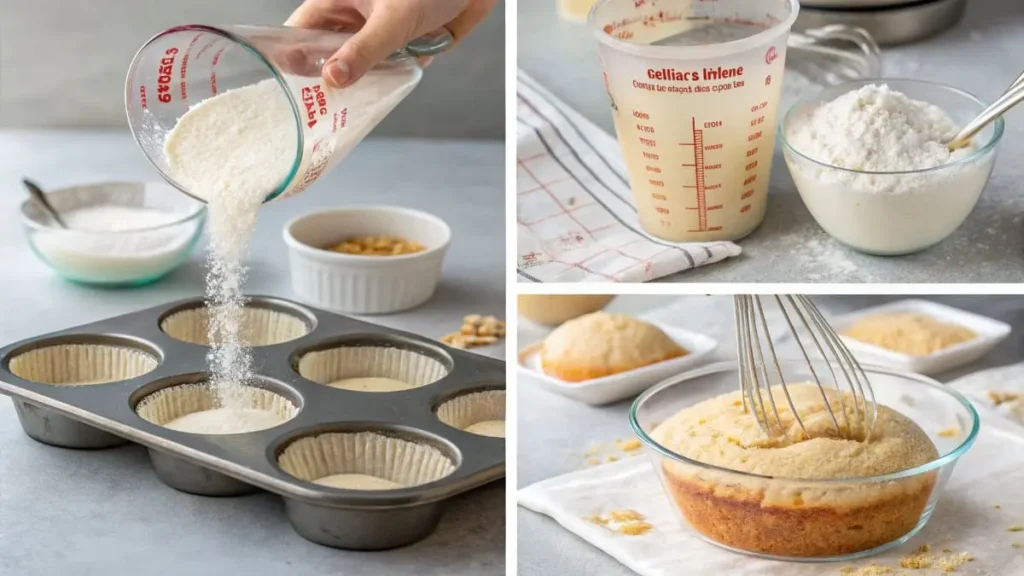
Conclusion: Your Path to Gluten-Free Baking Mastery Begins Now!
The world of gluten-free flour blends is vast, exciting, and brimming with culinary potential! Each flour we’ve explored – from the humble rice flour to the flavorful buckwheat and the absorbent coconut flour – offers unique properties and possibilities for your gluten-free kitchen. By understanding these characteristics, their uses, and limitations, you are now well-equipped to make informed choices, craft your successful flour blends, and achieve truly amazing results in your gluten-free baking and cooking.
Whether you’re a novice baker or a seasoned culinary enthusiast, this knowledge empowers you to confidently bake beyond wheat and create delicious, satisfying meals and treats that cater to dietary needs and expand your culinary horizons. So, venture forth, experiment with different blends, embrace new techniques, and embark on your journey to gluten-free baking mastery! Savor the process of discovery, and most importantly, enjoy the deliciousness you create.
Always remember to double-check labels to ensure all your ingredients are certified gluten-free, especially for those with celiac disease or severe gluten sensitivities, to prevent cross-contamination and ensure your gluten-free creations are safe and enjoyable for everyone.
Happy gluten-free baking and cooking – may your flour power be strong and your creations be delicious!
Frequently Asked Questions (FAQs) About Gluten-Free Flour Blends
Q1: What is a gluten-free flour blend?
Answer: A gluten-free flour blend is a mix of different flours that don’t contain gluten, the protein found in wheat, barley, and rye. These blends are designed to act more like regular wheat flour in baking and cooking, making it easier to create gluten-free versions of your favorite recipes. They often include a combination of grain flours (like rice flour), starches (like tapioca or potato starch), and sometimes nut or bean flours.
Q2: What is a gluten-free flour blend made of?
Answer: Gluten-free flour blends are typically made from a combination of different gluten-free flour and starches. Common ingredients include:
- Grain Flours: Rice flour (brown, white, sweet), sorghum flour, millet flour, oat flour (certified gluten-free).
- Starches: Tapioca starch (also called tapioca flour), potato starch, cornstarch, arrowroot starch.
- Nut Flours: Almond flour, and coconut flour (used in smaller amounts due to their strong flavor and texture).
- Bean Flours: Chickpea flour, fava bean flour (less common in general blends, but can be found).
- Binders (sometimes): Xanthan gum or guar gum are often added to mimic the binding effect of gluten in traditional baking.
Q3: Can I substitute gluten-free flour blend for regular flour?
Answer: Yes, in many recipes, you can substitute gluten-free flour blend for regular wheat flour. However, it’s not always a direct 1:1 substitution. Gluten-free blends behave differently than wheat flour. It’s best to use recipes specifically designed for gluten-free flour blends, especially when baking. For simpler things like coating chicken or thickening sauces, a 1:1 substitution often works well. Look for blends labeled “all-purpose” or “1-to-1” for easier substitution in baking.
Q4: How do you use a gluten-free flour blend for baking?
Answer: Baking with gluten-free flour blends is a bit different from baking with wheat flour. Here are some tips:
- Use recipes designed for gluten-free blends: These recipes are formulated to balance the different properties of gluten-free flour.
- Measure accurately: Precise measurements are even more important in gluten-free baking. Use measuring cups and spoons correctly.
- Don’t overmix: Overmixing can lead to tough baked goods. Mix just until the ingredients are combined.
- Consider adding extra moisture: Gluten-free flour can be drier than wheat flour. Recipes may call for extra liquid or fat.
- Use xanthan gum or guar gum (if not already in the blend): These gums help bind ingredients and provide structure, mimicking gluten.
- Let batters rest (sometimes): Some gluten-free batters benefit from a short rest before baking to allow the flours to fully hydrate.
Q5: Is gluten-free flour blend healthy?
Answer: Whether gluten-free flour blend is “healthy” depends on what you mean by healthy! Gluten-free blends can be a necessary choice for people with celiac disease or gluten sensitivity. However, just because something is gluten-free doesn’t automatically make it healthier.
- Nutritionally: Some gluten-free blends can be lower in fiber and certain nutrients compared to whole wheat flour, but blends made with whole grain gluten-free flour (like brown rice flour or sorghum flour) can be nutritious.
- Ingredients matter: The healthfulness depends on the specific ingredients in the blend. Blends with a lot of refined starches might be less nutrient-dense than those with more whole-grain flours and nut flours.
- Processed food: Gluten-free baked goods made with blends are still often processed foods. It’s about balance and choosing recipes with wholesome ingredients when possible.
Q6: What is the best gluten-free flour blend for bread? (or cakes, cookies, etc. – recipe specific)
Answer: There isn’t one *single* “best” gluten-free flour blend for *everything*. Different blends work better for different types of baking.
- For bread: Look for blends specifically labeled for bread making. These often have a higher protein content and may include ingredients to improve elasticity and rise.
- For cakes and muffins: All-purpose blends or blends with a slightly higher starch content can work well for soft and tender cakes.
- For cookies and pie crusts: Blends with a mix of flours and starches, and sometimes nut flours, can create good texture and flavor.
- Experimentation: It’s often about trying different blends and seeing what you like best for your specific recipes.
Q7: Can I make my gluten-free flour blend?
Answer: Yes, you absolutely can make your gluten-free flour blend! Making your blend allows you to control the ingredients and tailor it to your specific needs and preferences. It can also be more cost-effective than buying pre-made blends. To make your own, you’ll need to understand the properties of different gluten-free flours and starches and experiment with ratios to achieve the desired results for your baking. Many recipes and guides online can help you create custom blends.


